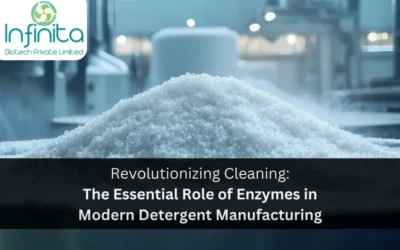Enzymes are used in biological detergents for cleaning laundry and crockery. Other than efficient cleaning, using enzymes in detergents are sustainable and also save energy as they function in low temperatures and do not require heated water.
Most of these detergents are created with a mix of 2 or more enzymes and can go up to 8 different enzymes in a single formulation. These blends make the enzymes more tolerant of the ingredients in the detergent that include surfactants, builders, bleaching chemicals, and alkaline salts. Multi enzyme detergents have even replaced about 25% of the laundry detergent surfactants without any losses in cleaning performance.
The History of Detergent Enzymes
“Burnus”, the first detergent enzyme was patented and sold in Germany in 1914. The detergent did not perform well due to insufficient activity and poor stability with other constituents of the detergent. After the introduction of better alkali-and-builder-stable proteases from the 1960s onwards, the use of enzymes in detergents gained prominence. These enzymes included proteases, amylases, lipases, cellulases, mannanases, and pectate lyases.
How Enzymes Work in Detergents
Enzyme detergent formulation usually comprises enzymes, surfactants, and builders. Dirt, stains, and grease from laundry and utensils are removed through mechanical action (washing machines, dishwasher, by hand) with the help of enzymes, surfactants, and builders present in detergents. Alkaline proteases, amylases, and lipases help in cleaning by breaking down the dirt through hydrolysis. Cellulases work on fabrics by hydrolysis of glycosidic bonds in fabrics that remove pilling, fuzz or lint attached to cotton microfibers. They also improve the softness and brightness of worn and jaded clothes. Surfactants act by lowering the surface tension in liquid solution and builders act by providing alkalinity to the solution that prevents the dirt from reattaching to the fabric.
Most Used Detergent Enzymes
The most popular class of enzymes used in detergents are hydrolases, which remove stains from fat, protein, and polysaccharide dirt. Some examples of stains include food, grass, blood, animal and vegetable fat, and dirt. The major types of hydrolases used in detergents include proteases, amylases, lipases, and mannanases. Other classes of enzymes like cellulases and pectinases also have specific applications in detergent formulations.
Let us look at these detergent enzymes in detail below.
1. Proteases
Proteases, particularly “Serine proteases” are commonly used for cleaning protein and dirt stains in both laundry and dishwashing. These include blood stains, egg stains, sweat, milk, and oatmeal stains among others. Proteases work through proteolysis which means they hydrolyze and break the peptide chain bonds of the stain or dirt stuck in fabrics or utensils.
2. Amylases
Amylases are used in enzyme detergent formulation for removing starchy stains. Some examples of starch stains are pasta, rice, potato, baby food, chocolate, and gravy stains. α-amylases are assisted by the gelatinization and swelling of cooked food to remove the starch stains quickly. They also prevent the swollen starch from sticking to crockery and fabric surfaces. Food items include a mix of fat, protein, and starch. Hence a multi-enzyme preparation for effective stain removal is required.
3. Lipases
Fats, grease, and oils repel water and thus are difficult to remove from fabrics. Lipases work by hydrolyzing or breaking down stubborn oil and fat particles(triglycerides) to mono- and diglycerides, free fatty acids, and glycerol. These are hydrophilic products and soluble in alkaline water solutions.
4. Mannanases and Pectinases
Mannanases and pectinases can be used as detergent enzymes that remove fruit and vegetable stains, grass stains, milk product stains, and wine stains. Examples include stains by ketchup, salad dressings, marmalades, juices, yoghurts, milkshakes, mayonnaise, etc. Mannanases and Pectinases break down oligosaccharides and polysaccharides like mannan and pectin present in these food items into simple sugars that can then be washed away with water.
5. Cellulases
Cellulases break down β-1,4-glucosidic bonds present in cellulose in fabrics. It removes the pills and fuzz of cotton fabrics and makes the fabric softer and brighter in colour.
Why Detergent Enzymes are Preferred
Let us look at some of the reasons in favour of detergent enzymes.
1. Cost-effective
Using enzymes in detergents is a cost-effective option that offers higher yields. Detergent enzymes can easily work in lower washing temperatures. This is especially effective in colder regions saving energy used to heat water for washing purposes. These enzymes are mixed with other ingredients like surfactants and bleaching systems optimized for lower temperatures, thus creating cold-water detergents.
2. A Mix of Fabrics
Enzyme detergent formulations effective in cold water mean mixing different types of fabrics in a washing machine like wool and silk with cotton. Wool and silk can get damaged in higher temperatures and have to be washed separately. Using detergent enzymes, it is possible to wash these together, thus saving a lot of precious time and effort. Other than that, low temperatures are also optimum for dyed clothing as it reduces colour transfer.
3. Shorter Rinsing Times
Using detergent enzymes, washing is shortened by at least one rinse and requires much less effort if done by hand. This also saves water. They are also milder on the hands than harsh chemical-based detergents.
4. Efficient Cutlery Cleaning
Enzymes are more effective in cleaning stubborn dirt and food stains from cutlery items. Using enzymes also reduces the clouding of glassware and keeps them shiny.
5. Sustainable Option
Detergent enzymes are environmentally friendly. Enzymes are replacing phosphates, soda ash and other such chemicals in detergents that are harmful especially for aquatic life. Multi-enzyme formulations are better effective at removing a wide variety of stains.
Conclusion
The COVID-19 pandemic has brought to light the requirement for enhanced cleanliness in day to day life and hospitals have tremendously increased. High quality and efficient detergents have become essential ever since.
Detergent enzymes have several advantages over conventional cleaning methods. Since they are catalysts, they can be used in smaller quantities to prepare effective cleaning formulations. This is especially relevant in the current scenario where detergent manufacturers want to create compact yet effective cleaning products.







